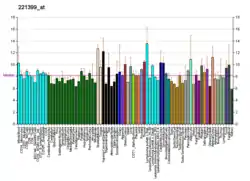Ectodysplasin A2 receptor
Tumor necrosis factor receptor superfamily member 27 is a protein that in humans is encoded by the EDA2R gene.[5][6]
EDA-A1 and EDA-A2 are two isoforms of ectodysplasin that are encoded by the anhidrotic ectodermal dysplasia (EDA) gene. Mutations in EDA give rise to a clinical syndrome characterized by loss of hair, sweat glands, and teeth. The protein encoded by this gene specifically binds to EDA-A2 isoform. This protein is a type III transmembrane protein of the TNFR (tumor necrosis factor receptor) superfamily, and contains 3 cysteine-rich repeats and a single transmembrane domain but lacks an N-terminal signal peptide. Multiple alternatively spliced transcript variants have been found for this gene, but some variants lack sufficient support.[6]
References
- GRCh38: Ensembl release 89: ENSG00000131080 - Ensembl, May 2017
- GRCm38: Ensembl release 89: ENSMUSG00000034457 - Ensembl, May 2017
- "Human PubMed Reference:". National Center for Biotechnology Information, U.S. National Library of Medicine.
- "Mouse PubMed Reference:". National Center for Biotechnology Information, U.S. National Library of Medicine.
- Yan M, Wang LC, Hymowitz SG, Schilbach S, Lee J, Goddard A, de Vos AM, Gao WQ, Dixit VM (Oct 2000). "Two-amino acid molecular switch in an epithelial morphogen that regulates binding to two distinct receptors". Science. 290 (5491): 523–7. Bibcode:2000Sci...290..523Y. doi:10.1126/science.290.5491.523. PMID 11039935.
- "Entrez Gene: EDA2R ectodysplasin A2 receptor".
Further reading
- Hashimoto T, Cui CY, Schlessinger D (2006). "Repertoire of mouse ectodysplasin-A (EDA-A) isoforms". Gene. 371 (1): 42–51. doi:10.1016/j.gene.2005.11.003. PMID 16423472.
- Gerhard DS, Wagner L, Feingold EA, et al. (2004). "The status, quality, and expansion of the NIH full-length cDNA project: the Mammalian Gene Collection (MGC)". Genome Res. 14 (10B): 2121–7. doi:10.1101/gr.2596504. PMC 528928. PMID 15489334.
- Sinha SK, Chaudhary PM (2004). "Induction of apoptosis by X-linked ectodermal dysplasia receptor via a caspase 8-dependent mechanism". J. Biol. Chem. 279 (40): 41873–81. doi:10.1074/jbc.M407363200. PMID 15280356.
- Clark HF, Gurney AL, Abaya E, et al. (2003). "The secreted protein discovery initiative (SPDI), a large-scale effort to identify novel human secreted and transmembrane proteins: a bioinformatics assessment". Genome Res. 13 (10): 2265–70. doi:10.1101/gr.1293003. PMC 403697. PMID 12975309.
- Strausberg RL, Feingold EA, Grouse LH, et al. (2003). "Generation and initial analysis of more than 15,000 full-length human and mouse cDNA sequences". Proc. Natl. Acad. Sci. U.S.A. 99 (26): 16899–903. Bibcode:2002PNAS...9916899M. doi:10.1073/pnas.242603899. PMC 139241. PMID 12477932.
- Sinha SK, Zachariah S, Quiñones HI, et al. (2003). "Role of TRAF3 and -6 in the activation of the NF-kappa B and JNK pathways by X-linked ectodermal dysplasia receptor". J. Biol. Chem. 277 (47): 44953–61. doi:10.1074/jbc.M207923200. PMID 12270937.
- Naito A, Yoshida H, Nishioka E, et al. (2002). "TRAF6-deficient mice display hypohidrotic ectodermal dysplasia". Proc. Natl. Acad. Sci. U.S.A. 99 (13): 8766–71. Bibcode:2002PNAS...99.8766N. doi:10.1073/pnas.132636999. PMC 124373. PMID 12060722.
External links
- EDA2R+protein,+human at the U.S. National Library of Medicine Medical Subject Headings (MeSH)




